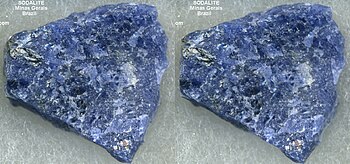Sodalite
| Sodalite | |
|---|---|
Tenebrescent ; violet-red or green fading to white |
Sodalite (
8(Al
6Si
6O
24)Cl
2, with royal blue varieties widely used as an ornamental gemstone. Although massive sodalite samples are opaque, crystals are usually transparent to translucent. Sodalite is a member of the sodalite group with hauyne, nosean, lazurite and tugtupite
The people of the
Structure
The structure of sodalite was first studied by
The structure is a crumpled form of a structure in which the three-fold axes of each tetrahedron lie in planes parallel to the faces of the unit cell, thus putting half the oxygen atoms in the faces. As the temperature is raised the sodalite structure expands and uncrumples, becoming more like this structure. In this structure the two cavities are still chiral, because no
The characteristic blue color arises mainly from caged S−3 and S4 clusters.[12]
Properties

A light, relatively hard yet fragile mineral, sodalite is named after its sodium content; in mineralogy it may be classed as a feldspathoid. Well known for its blue color, sodalite may also be grey, yellow, green, or pink and is often mottled with white veins or patches. The more uniformly blue material is used in jewellery, where it is fashioned into cabochons and beads. Lesser material is more often seen as facing or inlay in various applications.
Although somewhat similar to lazurite and lapis lazuli, sodalite rarely contains pyrite (a common inclusion in lapis) and its blue color is more like traditional royal blue rather than ultramarine. It is further distinguished from similar minerals by its white (rather than blue) streak. Sodalite's six directions of poor cleavage may be seen as incipient cracks running through the stone.
Most sodalite will
| Stereo image | |||
|---|---|---|---|
| |||
| |||
| |||
| |||
| Small specimen of sodalite from Brazil. | |||
Hackmanite

Hackmanite is a variety of sodalite exhibiting tenebrescence.[14] When hackmanite from Mont Saint-Hilaire (Quebec) or Ilímaussaq (Greenland) is freshly quarried, it is generally pale to deep violet but the color fades quickly to greyish or greenish white. Conversely, hackmanite from Afghanistan and the Myanmar Republic (Burma) starts off creamy white but develops a violet to pink-red color in sunlight. If left in a dark environment for some time, the violet will fade again. Tenebrescence is accelerated by the use of longwave or, particularly, shortwave ultraviolet light.
Occurrence
Sodalite was first described in 1811 for the occurrence in its
Occurring typically in massive form, sodalite is found as vein fillings in plutonic igneous rocks such as nepheline syenites. It is associated with other minerals typical of silica-undersaturated environments, namely leucite, cancrinite and natrolite. Other associated minerals include nepheline, titanian andradite, aegirine, microcline, sanidine, albite, calcite, fluorite, ankerite and baryte.[4]

Significant deposits of fine material are restricted to but a few locales:
Euhedral, transparent crystals are found in northern
Sodalitite is a type of
History
The people of the Caral culture traded for sodalite from the Collao altiplano.[17]
Synthesis
The
See also
References
- S2CID 235729616.
- ^ a b Mindat with locations
- ^ Webmineral data
- ^ a b Handbook of Mineralogy
- ISBN 0-471-80580-7
- ISBN 978-92-3-100020-1.
- ^ S2CID 102105382.
- ^ S2CID 93970848.
- .
- S2CID 96089478.
- ^ .
- .
- ]
- .
- ^ Ice River deposit on Mindat
- ^ ISBN 0-521-66215-X.
- ISBN 978-92-3-100020-1.
- .
- .
- .
- .
- .
External links
![]() Media related to Sodalite at Wikimedia Commons
Media related to Sodalite at Wikimedia Commons




